Use of Visible Spectral Index and Soybean Plant Variables to Study Hidden Nematicide Phytotoxicity
Abstract
1. Introduction
2. Materials and Methods
2.1. Experimental Area and Soybean Cultivars
2.2. Planting Substrate and Fertilization
2.3. Nematicide Treatments
2.4. Evaluations
2.5. Statistical Analysis
3. Results
3.1. Analysis of Variance
3.2. Falker Chlorophyll Index
3.3. Leaf Area, Mass, and Shoot Mass
3.4. Vegetation Spectral Indexes
3.5. Correlations
4. Discussion
5. Conclusions
Author Contributions
Funding
Data Availability Statement
Acknowledgments
Conflicts of Interest
References
- Companhia Nacional de Abastecimento (CONAB). Acompanhamento da Safra—Grãos. Safra 2022–2023, 10° Levantamento. Available online: http://www.conab.gov.br (accessed on 23 July 2022).
- Ogle, H.J. Abiotic Diseases of Plants. In Plant Pathogens and Plant Diseases; Brown, J.F., Ogle, H.J., Eds.; University of New England Printery: Armidale, Australia, 1997; pp. 156–171. [Google Scholar]
- Santos, D.M.M.; Ferraz, R.L.S.; Chiconato, D.A.; Pizolato Neto, A. Estresses abióticos na cultura da soja. In Doenças da soja: Melhoramento Genético e Técnicas de Manejo (Soybean Diseases: Genetic Improvement and Management Techniques); Lemes, E.M., Castro, L., Assis, R., Eds.; Publisher Millennium: Campinas, Brazil, 2015; pp. 137–158. [Google Scholar]
- Agrios, G.N. Plant Pathology, 5th ed.; Elsevier Academic Press: Burlington, VT, USA, 2005; 952p. [Google Scholar]
- Sabato, E.O.; Nicésio, F.J.A.P.; Fernandes, F.T. Identificação e Controle de Doenças do Milho (Identification and Control of Corn Diseases), 2nd ed.; Embrapa Informação Tecnológica: Brasília, Brazil, 2013; 145p. [Google Scholar]
- Lemes, E.; Castro, L.; Assis, R. Doenças da Soja: Melhoramento Genético e Técnicas de Manejo (Soybean Diseases: Genetic Improvement and Management Techniques); Millennium: Campinas, Brazil, 2015; 384p. [Google Scholar]
- Ferraz, L.C.C.B.; Brown, D.J.F. Nematologia de Plantas: Fundamentos e Importância (Plant Nematology: Fundamentals and Importance); Norma Editora: Manaus, Brazil, 2016; 268p. [Google Scholar]
- Decraemer, W.; Hunt, D., Jr. Structure and classification. In Plant Nematology; Perry, R.N., Moens, M., Eds.; CABI Publishing: Wallingford, UK, 2006; pp. 3–32. [Google Scholar]
- Nicol, J.M. Important nematode pests. In Bread Wheat Improvement and Production; Curtis, B.C., Rajaram, S., Gómez, M., Eds.; FAO Plant Production and Protection Series; Food and Agriculture Organization of the United Nations: Rome, Italy, 2002; pp. 345–366. Available online: https://www.fao.org/3/y4011e/y4011e0p.htm#bm25 (accessed on 1 August 2023).
- Perry, R.N.; Moens, M. Plant Nematology; Biddles: Pondicherry, India, 2005. [Google Scholar]
- Taylor, A.L.; Sasser, J.N. Biology, Identification, and Control of Root-Knot Nematodes (Meloidogyne); North Carolina State University and the United States Agency for International Development: Raleigh, NC, USA, 1978. [Google Scholar]
- Greco, N.; Di Vito, M. Population dynamics and damage levels. In Root-Knot Nematodes; Perry, R.N., Moens, M., Starr, J.L., Eds.; CAB International: Wallingford, UK, 2009; pp. 246–274. [Google Scholar]
- Moens, M.; Perry, R.N.; Starr, J.L. Meloidogyne sp.: A Diverse Group of Novel and Important Plant Parasite. In Root-Knot Nematodes; Perry, R.N., Moens, M., Starr, J.L., Eds.; CAB International: Wallingford, UK, 2009; pp. 1–17. [Google Scholar]
- Ghule, T.M.; Singh, A.; Khan, M.R. Root knot nematodes: Threat to indian agriculture. Pop. Kheti 2014, 2, 126–130. [Google Scholar]
- Karssen, G. The Plant-Parasitic Nematode Genus Meloidogyne Goldi, 892 (Tylenchida) in Europe; Brill: Leiden, The Netherlands, 2002; 157p. [Google Scholar]
- Jones, J.; Haegeman, A.; Danchin, E.G.; Gaur, H.S.; Helder, J.; Jones, M.G.; Kikuchi, T.; Manzanilla-López, R.; Palomares-Rius, J.E.; Wesemael, W.M.; et al. Top 10 plant-parasitic nematodes in molecular plant pathology. Mol. Plant Pathol. 2013, 14, 946–961. [Google Scholar] [CrossRef] [PubMed]
- Silva, G.S. Métodos Alternativos de Controle de Fitonematoides (Alternative Methods of Controlling Phytonematodes); Luz, C.W., Ed.; RAPP: New York, NY, USA, 2011; Volume 19, pp. 81–152. Available online: https://nematologia.com.br/files/rapp/rapp09.pdf (accessed on 22 February 2020).
- Safeena, M.I.S.; Zakeel, M.C.M. Nanobiotechnology-driven management of phytonematodes. In Management of Phytonematodes: Recent Advances and Future Challenges; Ansari, R., Rizvi, R., Mahmood, I., Eds.; Springer: Singapore, 2020; pp. 1–33. [Google Scholar] [CrossRef]
- Berthon, J.-Y.; Michel, T.; Wauquier, A.; Joly, P.; Gerbore, J.; Filaire, E. Seaweed and microalgae as major actors of blue biotechnology to achieve plant stimulation and pest and pathogen biocontrol—A review of the latest advances and future prospects. J. Agric. Sci. 2021, 159, 523–534. [Google Scholar] [CrossRef]
- Mandahl, H.R.; Katel, S.; Subedi, S.; Shrestha, J. Plant parasitic nematodes and their management in crop production: A review. J. Agric. Nat. Res. 2021, 4, 327–338. [Google Scholar] [CrossRef]
- Maru, A.K.; Singh; Prajapati, A.B.; Patel, D.J. Management of phytonematodes in vegetable crops through seed bio-priming: A review. Front. Crop Improv. 2021, 9, 2001–2007. [Google Scholar]
- Vitti, A.J.; Rezende Neto, U.R.; Araujo, F.G.; Santos, L.C.; Barbosa, K.A.G.; Rocha, M.R. Effect of soybean seed treatment with abamectin and thiabendazole on Heterodera glycines. Nematropica 2007, 44, 74–80. [Google Scholar]
- Corte, G.D.; Pinto, F.F.; Stefanello, M.T.; Gulart, C.; Ramos, J.P.; Balardin, R.S. Tecnologia de aplicação de agrotóxicos no controle de fitonematoides em soja (Technology for applying pesticides to control phytonematodes in soybeans). Ciênc. Rural 2014, 44, 1534–1540. [Google Scholar] [CrossRef]
- Santos, P.S. Aplicação em sulco de nematicidas em soja (In-furrow application of nematicides in soybeans). Master’s Thesis, UFSM, Programa de Pós-Graduação em Engenharia Agrícola, Santa Maria, Brazil, 2015; 51p. [Google Scholar]
- Pedrozo, I.B.O.; Henning, A.A.; Homechin, M. Controle químico do nematoide de cisto da soja Heterodera glycines em casa de vegetação (Chemical control of soybean cyst nematode Heterodera glycines in greenhouse). Sem. Ciênc. Agr. 1999, 20, 59–63. Available online: https://ojs.uel.br/revistas/uel/index.php/semagrarias/article/view/4212 (accessed on 22 February 2020).
- Oliveira, F.S.; Rocha, M.R.; Reis, A.J.S.; Machado, V.O.F.; Soares, R.A.B. Efeito de produtos químicos e naturais sobre a população de nematóide Pratylenchus brachyurus na cultura da cana-de-açúcar (Effect of chemical and natural products on the nematode population Pratylenchus brachyurus in sugarcane crops). Pesq. Agrop. Trop. 2005, 35, 171–178. [Google Scholar]
- Tayal, M.S.; Agarwal, M.L. Phytotoxicity of two nematicides, oxamyl and EDB, and its interaction with GA3 on the process of germination and amylase activity in Solanum melongena L. Bull. Société Bot. Fr. Lett. Bot. 1982, 129, 277–281. [Google Scholar] [CrossRef]
- Gowen, S.; Quénéhervè, P. Nematode parasites of bananas, plantains and abaca. In Plant Parasitic Nematodes in Subtropical and Tropical Agriculture; Luc, M., Sikora, R.A., Bridge, J., Eds.; CAB International: Wallingford, UK, 1990; Available online: https://horizon.documentation.ird.fr/exl-doc/pleins_textes/2021-09/34401.pdf (accessed on 20 February 2020).
- Steffen, R.B.; Steffen, G.P.K.; Antoniolli, Z.I.; Jacques, R.J.S.; Eckhardt, D.P. Efeito da abamectina e carbofuran no controle de danos causados por Meloidogyne graminicola em plantas de arroz irrigado (Effect of abamectin and carbofuran on controlling damage caused by Meloidogyne graminicola in irrigated rice plants). Rev. FZVA 2011, 18, 56–69. [Google Scholar]
- Dan, L.G.M.; Dan, H.A.; Piccinin, G.G.; Ricci, T.T.; Ortiz, A.H.T. Tratamento de sementes com inseticida e a qualidade fisiológica de sementes de soja (Seed treatment with insecticide and the physiological quality of soybean seeds). Rev. Caatinga 2012, 25, 45–51. [Google Scholar]
- Giannakou, I.O.; Panopoulou, S. The use of fluensulfone for the control of root-knot nematodes in greenhouse cultivated crops: Efficacy and phytotoxicity effects. Cogent Food Agric. 2019, 5, 1643819. [Google Scholar] [CrossRef]
- Sociedade Brasileira da Ciência das Plantas Daninhas. Procedimentos Para Instalação, Avaliação e Análise de Experimentos com Herbicidas (Procedures for Setting up, Evaluating and Analyzing Herbicide Experiments); SBCPD: Londrina, Brazil, 1995; 42p. [Google Scholar]
- Tucker, C.J. Red and photographic infrared linear combinations for monitoring vegetation. Remote Sens. Environ. 1979, 8, 127–150. [Google Scholar] [CrossRef]
- Basso, B.; Cammarano, D.; De Vita, P. Remotely sensed vegetation indices: Theory and applications for crop management. Ital. J. Agrometeorol. 2004, 53, 36–53. [Google Scholar]
- Jensen, J.R. Sensoriamento Remoto do Ambiente: Uma Perspectiva em Recursos Terrestres (Remote sensing of the environment: A Perspective on Terrestrial Resources), 2nd ed.; Epiphanio, J.C.N., Ed.; INPE: São José dos Campos, Brazil, 2009. [Google Scholar]
- Yoshioka, H.; Miura, T.; Obata, K. Derivation of relationships between spectral vegetation indices from multiple sensors based on vegetation isolines. Remote Sens. 2012, 4, 583–597. [Google Scholar] [CrossRef]
- Mahlein, A.-K. Plant disease detection by imaging sensors—Parallels and specific demands for precision agriculture and plant phenotyping. Plant Dis. 2016, 100, 241–251. [Google Scholar] [CrossRef]
- Xue, J.; Su, B. Significant remote sensing vegetation indices: A review of developments and applications. J. Sens. 2017, 1353691. [Google Scholar] [CrossRef]
- Kurbanov, R.; Zakharova, N. Justification and Selection of Vegetation Indices to Determine the Early Soybean Readiness for Harvesting. E3S Web Conf.-IterAgroMash 2021, 273, 01008. [Google Scholar] [CrossRef]
- Zeng, Y.; Hao, D.; Huete, A.; Berry, J.; Chen, J.M.; Joiner, J.; Frankenberg, C.; Bond-Lamberty, B.; Ryu, Y.; Xiao, J.; et al. Optical vegetation indices for monitoring terrestrial ecosystems globally. Nat. Rev. Earth Environ. 2022, 3, 477–493. [Google Scholar] [CrossRef]
- Pasternak, M.; Pawluszek-Filipiak, K. The evaluation of spectral vegetation indexes and redundancy reduction on the accuracy of crop type detection. Appl. Sci. 2022, 12, 5067. [Google Scholar] [CrossRef]
- Hunt, E.R.; Daughtry, C.S.T.; Eitel, J.U.H.; Long, D.S. Remote sensing leaf chlorophyll content using a visible band index. Agron. J. 2011, 103, 1090–1099. [Google Scholar] [CrossRef]
- Hunt, E.R.; Doraiswamy, P.C.; Mcmurtrey, J.E.; Daughtry, C.S.T.; Perry, E.M. A visible band index for remote sensing leaf chlorophyll content at the canopy scale. Int. J. Appl. Earth Obs. Geoinf. 2013, 21, 103–112. [Google Scholar] [CrossRef]
- Che’Ya, N.N.; Mohidem, N.A.; Roslin, N.A.; Saberioon, M.; Tarmidi, M.Z.; Arif Shah, J.; Fazlil Ilahi, W.F.; Man, N. Mobile computing for pest and disease management using spectral signature analysis: A review. Agronomy 2022, 12, 967. [Google Scholar] [CrossRef]
- Costopoulou, C.; Ntaliani, M.; Karetsos, S. Studying mobile apps for agriculture. IOSR J. Mob. Comput. Appl. 2016, 3, 44–49. [Google Scholar]
- Brown, R.H.; Kerry, B.R. Principles and Practice of Nematode Control in Crops; Academic Press: Sydney, Australia, 1987; 447p. [Google Scholar]
- Whitehead, A.G. Plant Nematode Control; CABI Publishing: Wallingford, UK, 1998; 384p. [Google Scholar]
- De Waele, D.; Elsen, A. Challenges in tropical plant nematology. Annu. Rev. Phytopathol. 2007, 45, 457–485. [Google Scholar] [CrossRef]
- Alvares, C.A.; Stape, J.L.; Sentelhas, P.C.; Gonçalves, J.L.M.; Sparovek, G. Köppen’s climate classification map for Brazil. Meteorol. Zeitschrift 2014, 22, 711–728. [Google Scholar] [CrossRef]
- Beck, H.E.; Zimmermann, N.E.; Mcvicar, T.R.; Vergopolan, N.; Berg, A.; Wood, E.F. Present and future Köppen-Geiger climate classification maps at 1-km resolution. Sci. Data 2018, 5, 180214. [Google Scholar] [CrossRef]
- Tuite, J. Plant Pathological Methods: Fungi and Bacteria; Burguess: Minneapolis, MN, USA, 1969; 239p. [Google Scholar]
- Vale, F.X.R.; Fernandes Filho, E.I.; Liberato, J.R. Quantificação de Doenças—Quant, Version 1.0.1; UFV: Viçosa, Brazil, 2001. [Google Scholar]
- Lemes, E.M.; Coelho, L.; Andrade, S.L.; Oliveira, A.S.; Marques, M.G.; Nascimento, F.M.A.; Cunha, J.P.A.R. Triangular greenness index to evaluate the effects of dicamba in soybean. AgriEngineering 2022, 4, 758–769. [Google Scholar] [CrossRef]
- Falker Automação Agrícola. Manual do Medidor Eletrônico de Teor Clorofila (ClorofiLOG—CFL 1030) (Electronic chlorophyll content meter manual (ClorofiLOG—CFL 1030)); Falker Automação Agrícola: Porto Alegre, Brazil, 2008; 33p. (Portuguese). Available online: http://www.falker.com.br/produto_download.php?id=4 (accessed on 28 December 2018).
- Pearson, K. The Grammar of Science; Walter Scott: London, UK, 1892; 493p. [Google Scholar]
- Chambers, J.; Cleveland, W.; Kleiner, B.; Tukey, P. Graphical Methods for Data Analysis; Wadsworth e Brooks/Cole: Pacific Grove, CA, USA, 1983; 395p. [Google Scholar]
- Paranhos, R.; Figueiredo Filho, D.B.; Rocha, E.C.; Silva Júnior, J.A.; Neves, J.A.B.; Santos, M.L.W.D. Desvendando os mistérios do coeficiente de correlação de Pearson: O retorno (Unraveling the mysteries of the Pearson correlation coefficient: The comeback). Leviathan 2014, 8, 66–95. [Google Scholar] [CrossRef]
- Figueiredo Filho, D.B.; Silva, J.A., Jr. Desvendando os mistérios do coeficiente de correlação de Pearson (r) (Unraveling the mysteries of the Pearson correlation coefficient (r)). Rev. Política Hoje 2009, 18, 115–146. [Google Scholar]
- Callegari-Jacques, S.M. Bioestatística: Princípios e aplicações (Biostatistics: Principles and Applications); Artemed: Porto Alegre, Brazil, 2003; 255p. [Google Scholar]
- Croft, H.; Chen, J.M. Leaf pigment content. In Comprehensive Remote Sensing, 3rd ed.; Remote Sensing of Terrestrial Ecosystems; Chen, J.M., Liang, S., Eds.; Elsevier Inc.: Amsterdam, The Netherlands, 2018; pp. 117–142. [Google Scholar] [CrossRef]
- Li, Y.; He, N.; Hou, J.; Xu, L.; Liu, C.; Zhang, J.; Wang, Q.; Zhang, X.; Wu, X. Factors influencing leaf chlorophyll content in natural forests at the biome scale. Front. Ecol. Evol. 2018, 6, 64. [Google Scholar] [CrossRef]
- Kandel, Y.R.; Wise, K.A.; Bradley, C.A.; Tenuta, A.U.; Mueller, D.S. Effect of planting date, seed treatment, and cultivar on plant population, sudden death syndrome, and yield of soybean. Plant Dis. 2016, 100, 1735–1743. [Google Scholar] [CrossRef] [PubMed]
- Jones, J.G.; Kleczewski, N.M.; Desaeger, J.; Meyer, S.L.F.; Johnson, G.C. Evaluation of nematicides for southern root-knot nematode management in lima bean. Crop Prot. 2017, 96, 151–157. [Google Scholar] [CrossRef]
- Zambiazzi, E.V.; Bruzi, A.T.; Silva, F.D.S.; Silva, E.V.V.; Zuffo, A.M.; Guilherme, S.R.; Monteiro, F.F.; Mendes, A.E.S.; Carvalho, A.H.F.; Carvalho, M.L.M. Development of plants in combination of products associated with the inoculation in the soybean seeds treatment. J. Agric. Sci. 2017, 9, 123–130. [Google Scholar] [CrossRef][Green Version]
- Ali, A.A.I.; Khairy, A.M.; El-Ashry, R.M. Nematicidal activity, oxidative stress and phytotoxicity of Virkon®S on tomato plants infected with root-knot nematode. Egypt J. Agronematology 2023, 22, 19–40. [Google Scholar] [CrossRef]
- Guarniere, C.C.O. Eficácia de Tiodicarbe, Cadusafós e Condicionador de Solo via Tratamento de Sementes e/ou Sulco de Plantio no Controle de Nematoides na Cultura de Soja (Efficacy of Thiodicarb, Cadusaphos and Soil Conditioner via Seed Treatment and/or Planting Furrow in Controlling Nematodes in Soybean Crops). Master’s Thesis, Universidade Estadual Paulista, Jaboticabal, Brazil, 2018; p. 73. [Google Scholar]
- Dale, M.P.; Causton, D.R. Use of the chlorophyll a/b ratio as a bioassay for the light environment of a plant. Funct. Ecol. 1992, 6, 190–196. [Google Scholar] [CrossRef]
- Kitajima, K.; Hogan, K.P. Increases of chlorophyll a/b ratios during acclimation of tropical woody seedlings to nitrogen limitation and high light. Plant Cell Environ. 2003, 26, 857–865. [Google Scholar] [CrossRef]
- Fritschi, F.B.; Ray, J.D. Soybean leaf nitrogen, chlorophyll content, and chlorophyll a/b ratio. Photos 2007, 45, 92–98. [Google Scholar] [CrossRef]
- Higaki, W.A. Bacillus subtilis e Abamectina no Controle de Rotylenchulus reniformis e Pratylenchus brachyurus e Alterações Fisiológicas em Algodoeiro em Condições Controladas (Bacillus subtilis and abamectin in the control of Rotylenchulus reniformis and Pratylenchus brachyurus and Physiological Changes in Cotton under Controlled Conditions). Master’s Thesis, Universidade do Oeste Paulista, Presidente Prudente, Brazil, 2012. [Google Scholar]
- Vitti, A.J.; Rezende-Neto, U.R.; Araújo, F.G.; Santos, L.C.; Barbosa, K.A.G.; Rocha, M.R. Efeito do tratamento de sementes de soja com abamectina e tiabendazol em Heterodera glycines (Effect of treating soybean seeds with abamectin and thiabendazole on Heterodera glycines). Nematropica 2014, 44, 74–80. [Google Scholar]
- Oriani, E.E. Metodologias de Aplicação de Sulfonamida Heterocíclica no Controle de Meloidogyne javanica e Pratylenchus brachyurus em soja (Methodologies for applying heterocyclic sulfonamide to control Meloidogyne javanica and Pratylenchus brachyurus in soybeans). Master’s Thesis, Universidade Estadual Paulista Júlio de Mesquita Filho, Faculdade de Ciências Agrárias e Veterinárias de Jaboticabal, Jaboticabal, Brazil, 2015; 64p. Available online: http://hdl.handle.net/11449/128105 (accessed on 25 February 2020).
- Nunes, H.T.; Monteiro, C.H.; Pomela, A.W.V. Uso de agentes microbianos e químicos para o controle de Meloidogyne incognita em soja. Acta Sci. Agron. Mar. 2010, 32, 403–409. [Google Scholar] [CrossRef][Green Version]
- Baggio, L.G.; Ruffato, S.; Bonaldo, S.M. Nematicida biológico, fungicidas e inseticidas aplicados via semente, no desempenho da cultura da soja no Norte de Mato Grosso (Biological nematicide, fungicides and insecticides applied via seed, on the performance of soybean crops in the North of Mato Grosso). Sci. Electron. Arch. 2016, 9, 2. [Google Scholar]
- Vieira, A.; Ruggiero, C.; Marin, S.L.D. Fitotoxicidade de fungicidas, acaricidas e inseticidas, sobre o mamoeiro (Carica papaya L.) cultivar sunrise solo improved line 72/12 em condições de campo (Improved phytotoxicity of fungicides, acaricides and insecticides on papaya (Carica papaya L.) cultivar sunrise soil line 72/12 under field conditions). Rev. Bras. Frut. 2001, 23, 315–319. [Google Scholar] [CrossRef]
- Romano, M.J.; Correia, E.C.S.S.; Monteiro, R.N.F.; Fontana, L.F.; Silva, D.P. Intervalos de aplicação de abamectina na supressão de Meloidogyne enterolobii em tomateiro (Abamectin application intervals to suppress Meloidogyne enterolobii in tomato). Rev. Bras. Eng. Biossist. 2016, 10, 394–402. [Google Scholar] [CrossRef][Green Version]
- Manzanilla-López, R.H.; Esteves, I.; Finetti-Sialer, M.M.; Hirsch, P.R.; Ward, E.; Devonshire, J.; Hidalgo-Díaz, L. Pochonia chlamydosporia: Advances and challenges to improve its performance as a biological control agent of sedentary endo-parasitic nematodes. J. Nematol. 2013, 45, 1–7. [Google Scholar]
- Tardieu, F.; Cabrera-Bosquet, L.; Pridmore, T.; Bennett, M. Plant Phenomics, from Sensors to Knowledge. Curr. Biol. 2017, 27, R770–R783. [Google Scholar] [CrossRef]
- Li, Z.; Guo, R.; Li, M.; Chen, Y.; Li, G. A review of computer vision technologies for plant phenotyping. Comput. Electron. Agric. 2020, 176, 105672. [Google Scholar] [CrossRef]
- Omari, M.K.; Lee, J.; Faqeerzada, M.A.; Joshi, R.; Park, E.; Cho, B.K. Digital image-based plant phenotyping: A review. Korean J. Agric. Sci. 2020, 47, 119–130. [Google Scholar] [CrossRef]
- Singh, V.; Misra, A.K. Detection of plant leaf diseases using image segmentation and soft computing techniques. Inf. Process. Agric. 2016, 4, 41–44. [Google Scholar] [CrossRef]
- Rao, A.; Kulkarni, S.B. A hybrid approach for plant leaf disease detection and classification using digital image processing methods. Int. J. Electr. Eng. Educ. 2020, 2845320, 1–19. [Google Scholar] [CrossRef]
- Er-Raki, S.; Chehbouni, A. Remote sensing in irrigated crop water stress assessment. Remote Sens. 2023, 15, 911. [Google Scholar] [CrossRef]
- Sims, D.A.; Gamon, J.A. Relationships between leaf pigment content and spectral reflectance across a wide range of species, leaf structures and developmental stages. Remote Sens. Environ. 2002, 81, 337–354. [Google Scholar] [CrossRef]
- Leong, T.-Y.; Anderson, J.M. Adaptation of the thylakoid membranes of pea chloroplasts to light intensities. I. Study on the distribution of chlorophyll protein complexes. Photos Res. 1984, 5, 105–115. [Google Scholar] [CrossRef] [PubMed]
- Green, B.R.; Durnford, D.G. The chlorophyll-carotenoid proteins of oxygenic photosynthesis. Ann. Rev. Plant Phys. Plant Mol. Biol. 1996, 47, 685–714. [Google Scholar] [CrossRef] [PubMed]
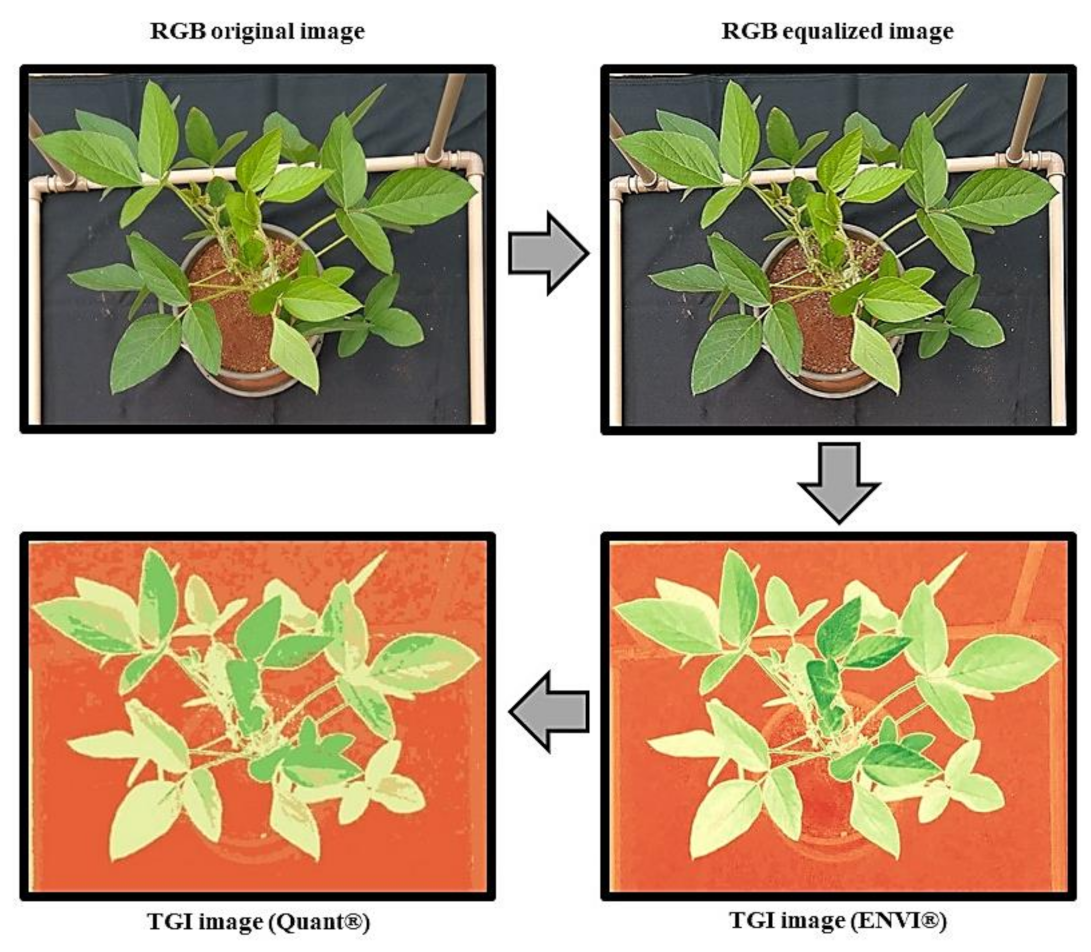
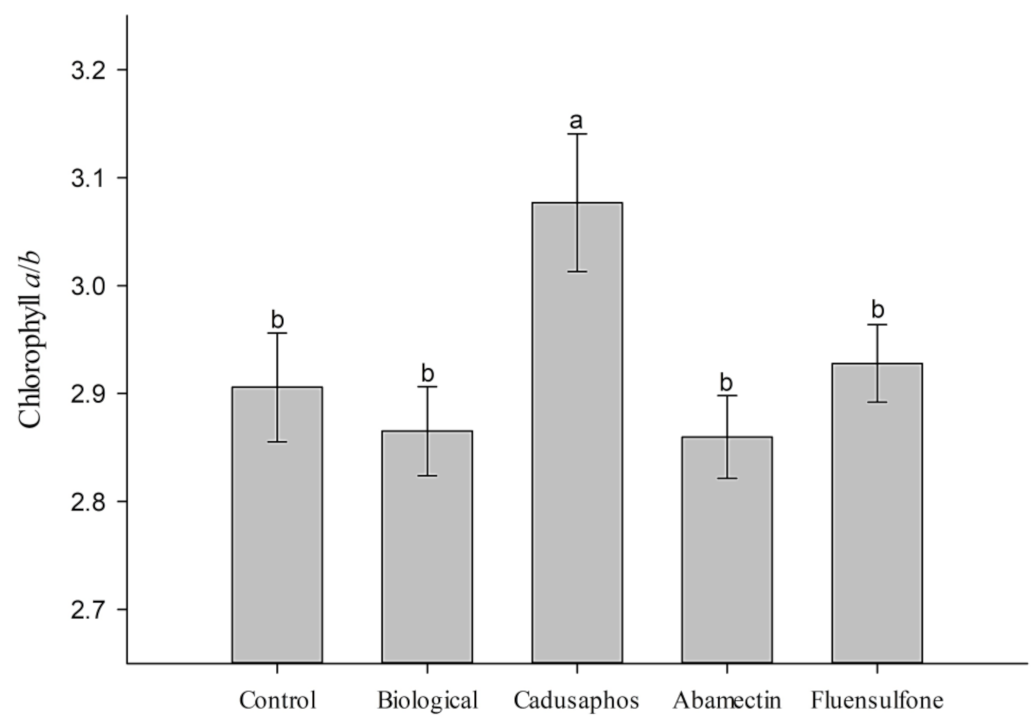
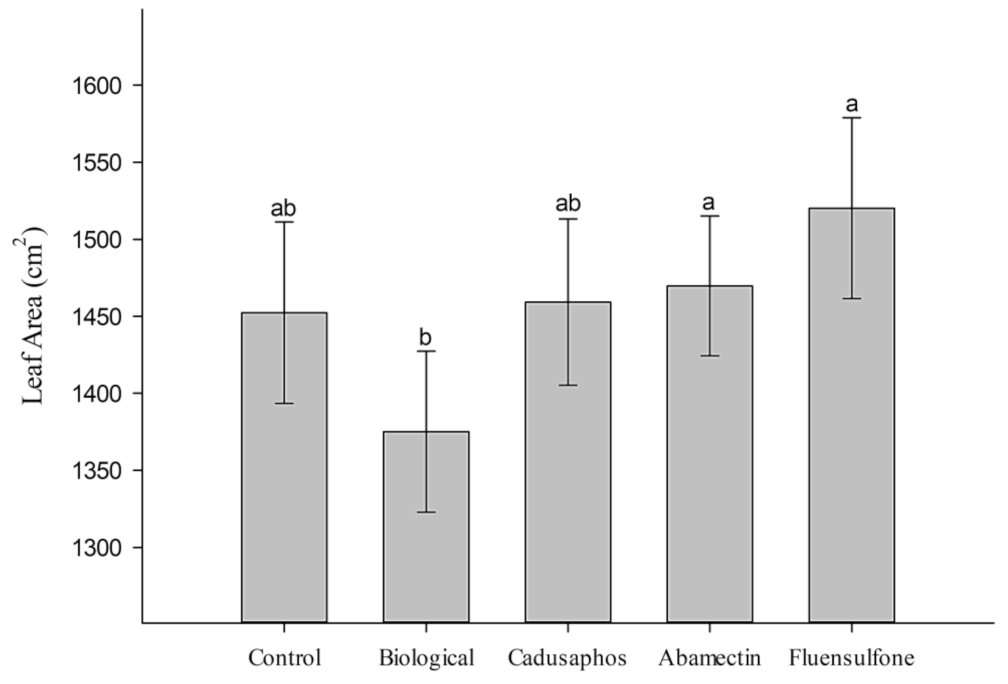
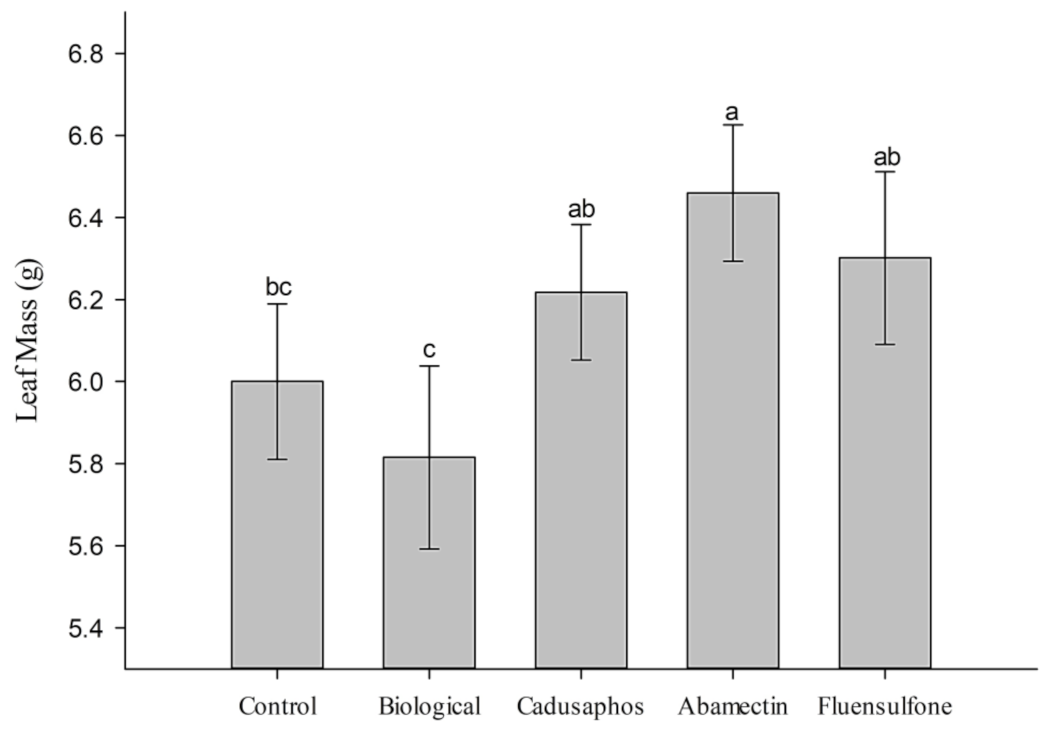
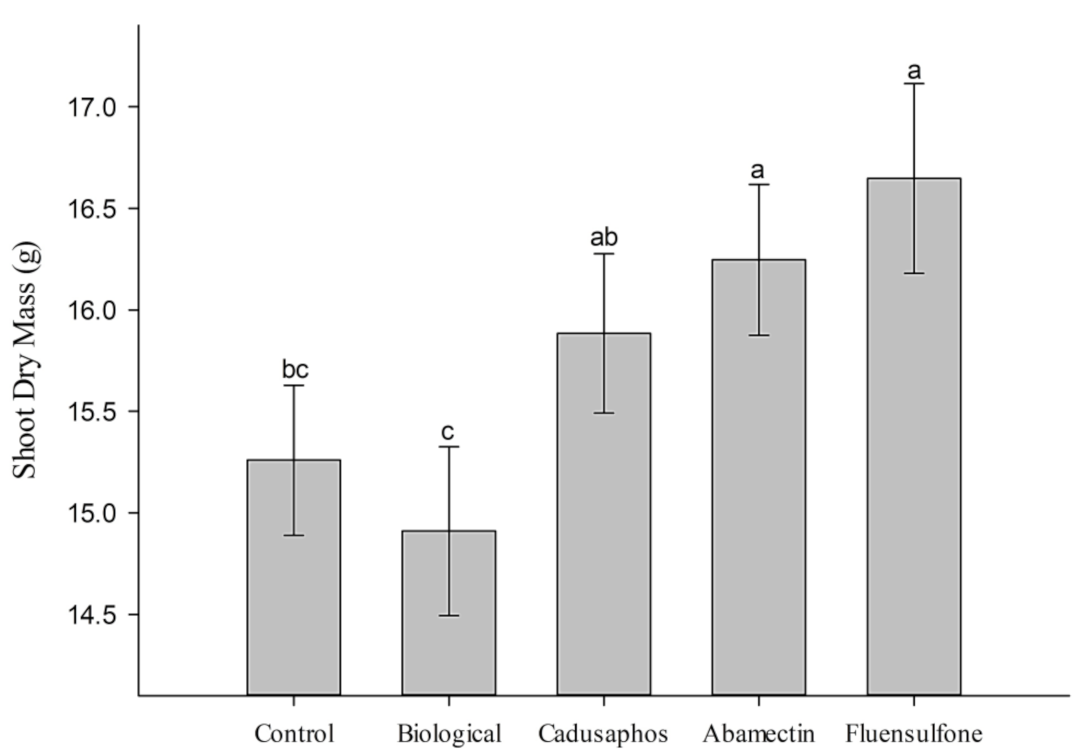
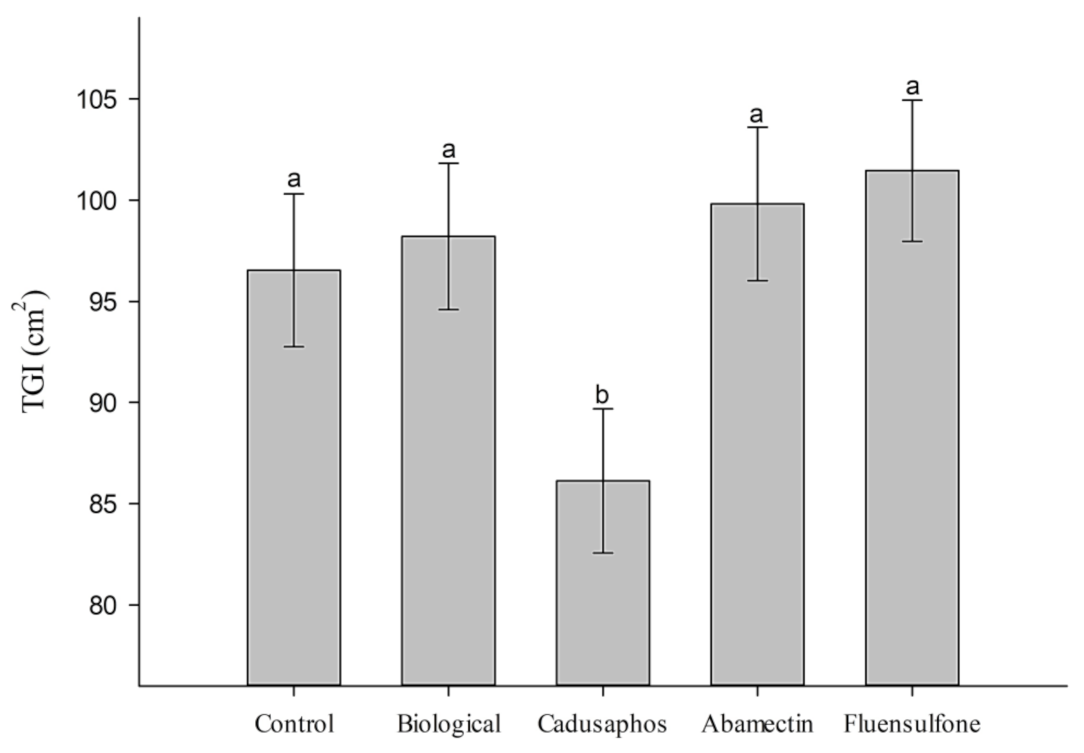

| Treatment | Active Ingredient | Commercial Concentration | Application Technology | Commercial Dose | Spray Volume Applied |
|---|---|---|---|---|---|
| Biological | Pochonia chlamydosporia | 5.2 × 107 spores g−1 | In-furrow spray | 3 kg ha−1 | 200 L ha−1 |
| Chemical | cadusaphos | 200 g kg−1 | In-furrow spray | 4 L ha−1 | 200 L ha−1 |
| abamectin | 500 g L−1 | Seed treatment | 1.25 mL kg−1 | 5 mL kg−1 | |
| fluensulfone | 480 g L−1 | In-furrow spray | 0.5 L ha−1 | 200 L ha−1 |
| SV | DF | Chlor.a1 | Chlor.b1 | Chlor.T1 | Chlor.a/b1 | Chlor.a2 | Chlor.b2 | Chlor.T2 | Chlor.a/b2 | Leaf cm2 | Leaf g | Shoot g | TGI 1 | TGI 2 |
|---|---|---|---|---|---|---|---|---|---|---|---|---|---|---|
| Soybean (S) | 1 | 0.470 | 12.235 ** | 1.696 | 16.622 ** | 3.602 | 2.728 | 3.858 | 0.870 | 168.475 ** | 59.545 ** | 32.690 ** | 14.918 ** | 30.224 ** |
| Nematicide (N) | 4 | 6.021 ** | 6.167 ** | 7.784 ** | 4.105 ** | 2.037 | 1.874 | 2.138 | 1.082 | 2.517 * | 3.267 * | 5.238 ** | 3.320 * | 1.689 |
| S * N | 4 | 6.249 ** | 3.295 * | 6.060 ** | 0.654 | 2.331 | 1.511 | 2.372 | 0.632 | 0.981 | 0.142 | 0.333 | 2.219 | 0.647 |
| CV (%) | 4.12 | 9.33 | 4.77 | 7.35 | 5.64 | 9.46 | 6.02 | 6.76 | 11.06 | 11.16 | 9.61 | 16.85 | 10.46 | |
| KS | 119 | 0.052 + | 0.056 + | 0.062 + | 0.041 + | 0.036 + | 0.035 + | 0.048 + | 0.060 + | 0.056 + | 0.059 + | 0.042 + | 0.087 + | 0.056 + |
| L | 119 | 2.263 | 1.855 + | 2.590 | 1.372 + | 0.958 + | 1.607 + | 0.993 + | 1.727 + | 0.860 + | 0.730 + | 0.964 + | 1.580 + | 1.389 + |
| Soybean | Control | Biological | Cadusaphos | Abamectin | Fluensulfone |
|---|---|---|---|---|---|
| Chlorophyll a | |||||
| 8473 RSF | 31.22 aA 1 | 31.88 aA | 29.15 bB | 32.18 aA | 30.99 bA |
| M7198 IPRO | 30.98 aA | 31.03 aA | 31.00 aA | 31.03 bA | 32.19 aA |
| Chlorophyll b | |||||
| 8473 RSF | 11.31 aA | 11.54 aA | 9.74 aB | 11.59 aA | 10.74 aAB |
| M7198 IPRO | 10.27 bA | 10.09 bA | 9.85 aA | 10.63 bA | 10.93 aA |
| Chlorophyll a + b | |||||
| 8473 RSF | 42.53 aA | 43.43 aA | 38.89 bB | 43.77 aA | 41.74 aA |
| M7198 IPRO | 41.25 aA | 41.11 bA | 40.85 aA | 41.65 bA | 43.11 aA |
| Chlor.a1 | Chlor.b1 | Chlor.T1 | Chlor.a/b1 | Chlor.a2 | Chlor.b2 | Chlor.T2 | Chlor.a/b2 | Leaf cm2 | Leaf g | Shoot g | TGI 1 | TGI 2 | |
|---|---|---|---|---|---|---|---|---|---|---|---|---|---|
| Chlor.a1 | 1 | 0.616 ** | 0.928 ** | −0.229 * | −0.108 | 0.049 | −0.060 | −0.106 | 0.126 | 0.134 | 0.174 | 0.173 | 0.064 |
| Chlor.b1 | 1 | 0.865 ** | −0.835 ** | −0.006 | 0.199 * | 0.066 | −0.242 ** | −0.157 | −0.148 | −0.044 | 0.228 * | −0.061 | |
| Chlor.T1 | 1 | −0.541 ** | −0.072 | 0.125 | −0.007 | −0.182 * | 0.005 | 0.015 | 0.090 | 0.218 * | 0.012 | ||
| Chlor.a/b1 | 1 | −0.038 | −0.183 * | −0.092 | 0.183 * | 0.289 ** | 0.222 * | 0.105 | −0.191 * | 0.105 | |||
| Chlor.a2 | 1 | 0.725 ** | 0.970 ** | −0.263 ** | −0.231 * | −0.174 | −0.111 | 0.086 | −0.210 * | ||||
| Chlor.b2 | 1 | 0.871 ** | −0.823 ** | −0.190 * | −0.112 | −0.058 | 0.212 * | −0.125 | |||||
| Chlor.T2 | 1 | −0.478 ** | −0.232 * | −0.163 | −0.100 | 0.136 | −0.194 * | ||||||
| Chlor.a/b2 | 1 | 0.099 | 0.014 | 0.009 | 0.198 * | 0.052 | |||||||
| Leaf cm2 | 1 | 0.791 ** | 0.719 ** | 0.315 ** | 0.571 ** | ||||||||
| Leaf g | 1 | 0.852 ** | 0.212 * | 0.355 ** | |||||||||
| Shoot g | 1 | 0.308 * | 0.376 ** | ||||||||||
| TGI 1 | 1 | 0.332 ** | |||||||||||
| TGI 2 | 1 |
Disclaimer/Publisher’s Note: The statements, opinions and data contained in all publications are solely those of the individual author(s) and contributor(s) and not of MDPI and/or the editor(s). MDPI and/or the editor(s) disclaim responsibility for any injury to people or property resulting from any ideas, methods, instructions or products referred to in the content. |
© 2023 by the authors. Licensee MDPI, Basel, Switzerland. This article is an open access article distributed under the terms and conditions of the Creative Commons Attribution (CC BY) license (https://creativecommons.org/licenses/by/4.0/).
Share and Cite
Lemes, E.M.; Santos, M.A.d.; Coelho, L.; Andrade, S.L.d.; Oliveira, A.d.S.; Pessoa, I.D.; Cunha, J.P.A.R. Use of Visible Spectral Index and Soybean Plant Variables to Study Hidden Nematicide Phytotoxicity. AgriEngineering 2023, 5, 1737-1753. https://doi.org/10.3390/agriengineering5040107
Lemes EM, Santos MAd, Coelho L, Andrade SLd, Oliveira AdS, Pessoa ID, Cunha JPAR. Use of Visible Spectral Index and Soybean Plant Variables to Study Hidden Nematicide Phytotoxicity. AgriEngineering. 2023; 5(4):1737-1753. https://doi.org/10.3390/agriengineering5040107
Chicago/Turabian StyleLemes, Ernane Miranda, Maria Amélia dos Santos, Lísias Coelho, Samuel Lacerda de Andrade, Aline dos Santos Oliveira, Igor Diniz Pessoa, and João Paulo Arantes Rodrigues Cunha. 2023. "Use of Visible Spectral Index and Soybean Plant Variables to Study Hidden Nematicide Phytotoxicity" AgriEngineering 5, no. 4: 1737-1753. https://doi.org/10.3390/agriengineering5040107
APA StyleLemes, E. M., Santos, M. A. d., Coelho, L., Andrade, S. L. d., Oliveira, A. d. S., Pessoa, I. D., & Cunha, J. P. A. R. (2023). Use of Visible Spectral Index and Soybean Plant Variables to Study Hidden Nematicide Phytotoxicity. AgriEngineering, 5(4), 1737-1753. https://doi.org/10.3390/agriengineering5040107






